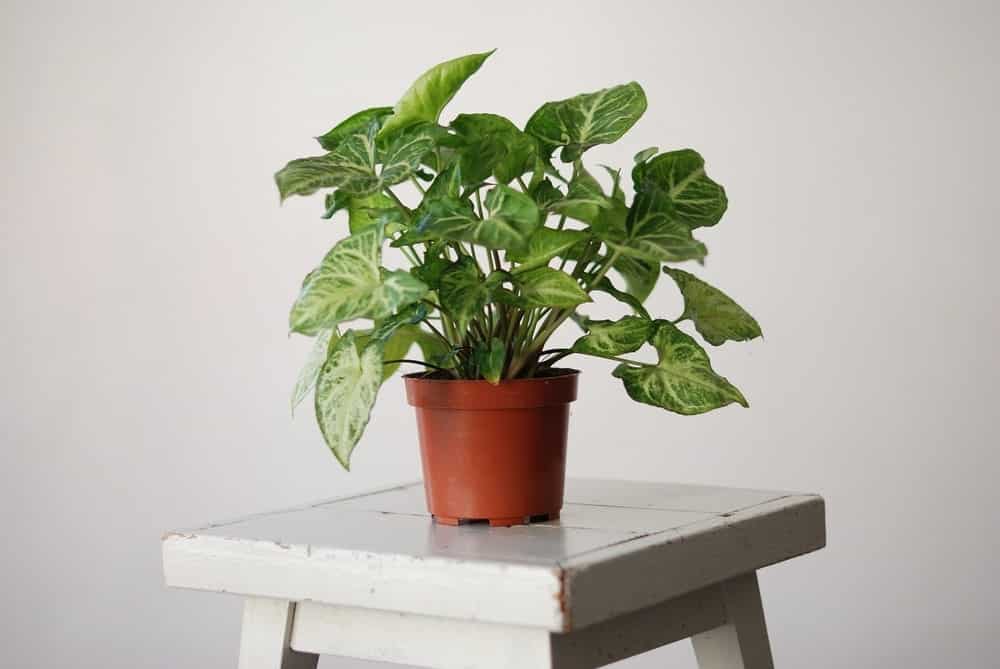Syngonium plants, also known as arrowhead vines, require very little specialized care when kept as houseplants.
Provide indirect light and maintain moist soil at all times, misting occasionally. Allow plenty of space for the vines to grow or prune to shape the plant. Keep ambient temperature between 60 and 80 degrees. Fertilizer is generally not required and syngonium plants are resistant to most common diseases and pests.
Syngonium Plant Care and Growing Guide
1. Light
Syngonium plants prefer bright indirect light, and are therefore well-suited to be kept as houseplants. Syngonium will tolerate lower light environments and are appropriate for most indoor locations.
They are sensitive to direct sunlight and can scorch or sunburn in bright direct sunlight. Syngonium plants with mostly green leaves can tolerate lower levels of light, but plants prefer brighter light to increase their color. Some varieties of syngonium prefer brighter light, but are highly versatile tropical plants.
2. Water
Syngonium plants require frequent moderate watering and should not be allowed to dry out. Keep the soil moderately moist at all times. Ensure that the container has good drainage to avoid the soil becoming soggy. Never allow standing water to accumulate in the pot, as this can lead to root rot. Misting this plant will also encourage healthy humidity and lush growth.
3. Soil
Use a rich potting soil with organic materials to encourage healthy growth of your syngonium plant. Most potting soil blends are sufficient to grow healthy syngonium plants or vines.
4. Climate
In most zones and climates, syngonium plants are best suited for indoor life and prefer ambient temperatures between 60 and 80 degrees. They cannot tolerate cold temperatures. They do not require high humidity, but misting this plant is beneficial.
5. Outdoor Syngonium Plants
Syngonium plants are native to tropical rainforests in Central and South America. It may be grown outdoors in zones 10-12. Maintain moderate watering in humid climates. Plant in part-sun areas and allow plenty of space for the climbing vines outdoors.

6. Flowers and Leaves
Syngonium plants are leafy houseplants with showy variegation. Some varieties of these plants have solid-colored green foliage, but many have striking white veins or even pink leaves. The varieties with greater variegation require more sunlight than green-leafed plants. Dust the large leaves regularly to maintain aesthetics and to encourage growth. Syngonium plants kept indoors are not likely to flower. When kept outdoors in their native habitat, mature syngonium flowers are white and spoon-shaped with a tall central stalk.
7. Rate of Growth
Syngonium plants are generally considered easy to grow for beginner gardeners and experts alike. They grow vigorously when kept in a sunny space with indirect light and are watered often. They may be pruned to maintain a small bushy shape or allowed to grow long vines. The vines have a tendency to climb and may be trained on a trellis.
8. Height and Spread
Syngonium is a climbing plant and can grow long vines up to six feet in length. It may climb if permitted, but vines generally drape down from hanging planters. These plants can be pruned to a more compact size of about two to three feet in height. Some varieties such as the Pixie Allusion can be kept at a very small tabletop size.
9. Containers
Equally at home as table plants or in hanging baskets, syngonium are very adaptable plants for any interior decor. Choose a hanging basket with good drainage and a high clearance from the floor or any surface.
Vines may grow up to six feet in length and may need to be trimmed. If kept on a table or floor, maintain syngonium’s bushy shape with frequent pruning. The pot or container should be proportional to the size of the plant. It does not require very large containers.
Learn more: Oxalis Plant Care & Growing Guide
10. Companion Plants
Good companion plants for syngonium include dieffenbachia and ficus. Syngonium are often kept in a bushy shape and are best kept alone in their containers.
11. Propagation
Any pruned vines may be propagated as cuttings to grow new plants. Rest the vines in water until roots form, then plant in sterilized potting soil. Syngonium grows at a rapid rate and trimmed vines or cuttings will enthusiastically take root whenever possible.
12. Fertilization
Fertilize annually in the spring with balanced fertilizer or compost. Syngonium plants grow vigorously and usually do not require frequent fertilization.
13. Pruning
Syngonium, also known as arrowhead vines, will grow long dramatic vines. This is especially impactful when displayed as a hanging plant. Pruning the plant will keep it more of a compact bushy shape. Maintain regular trimming of exceptionally long vines to control this houseplant.
This is important since the leaves of the syngonium plant are toxic when ingested. Prevent vines from coming into easy reach of children or pets. To prune syngonium, pinch off new growth as it appears or trim vines to the correct length. Syngonium may be pruned at any time of the year. Remove yellowed leaves frequently.
14. Repotting
Syngonium is a vigorous plant and may need repotting as often as every two to three years. Stunted growth or roots protruding from the drainage holes of the pot may be an indication that your syngonium requires a larger pot. To repot this plant, choose a container 2-3” larger in diameter. Add potting soil to the base of the new container before repotting the syngonium.
Keep reading: Croton Mammy: Plant Care & Growing Guide
Common Diseases and Pests
Syngonium is resistant to most diseases and pests. However, syngonium may be susceptible to aphids or spider mites. Overwatering may cause fungal growth or mildew. Reduce watering and increase air flow if mildew becomes an issue.
Toxicity Warning
Syngonium leaves are toxic when ingested. Proper care of this plant requires keeping it out of reach of children and pets. Excessive handling of this plant may result in skin irritation.
Also read: Song of India: Growing Guide
Conclusion
When kept as houseplants, syngonium plants are easy to maintain in indirect light. They do not require a large amount of space, unless kept as hanging plants with long draping vines. Keep syngonium plants at room temperature (between 60 and 80 degrees) and water regularly. Mist the plant to maintain humidity.
More like this:
- Crested Euphorbia Plant Care & Growing Guide
- Stromanthe Triostar Care & Growing Guide
- Peperomia: Plant Care and Growing Guide
Victoria is the owner and main author of hobby plants. She loves spending her free time in her garden planting and taking care of her plants. Victoria hopes you enjoy the content here!




![Mother Of Thousands Plant [Complete Plant Care Guide] Mother Of Thousands Plant [Complete Plant Care Guide]](https://www.hobbyplants.com/wp-content/uploads/2022/07/mother-of-thousands-plant-300x158.jpg)
![Majesty Palm Plant Care: [Complete Beginner's Guide] Majesty Palm Plant Care: [Complete Beginner's Guide]](https://www.hobbyplants.com/wp-content/uploads/2022/08/majesty-palm-care-300x158.jpg)
![Exotic Angel Plant Care: [Complete Beginner's Guide] Exotic Angel Plant Care: [Complete Beginner's Guide]](https://www.hobbyplants.com/wp-content/uploads/2022/08/exotic-angel-plant-care-300x158.jpg)
![Snow White Waffle Plant: [Complete Care Guide] Snow White Waffle Plant: [Complete Care Guide]](https://www.hobbyplants.com/wp-content/uploads/2022/08/snow-white-waffle-plant-300x158.jpg)
![Waffle Plant Care: [Complete Beginner's Guide] Waffle Plant Care: [Complete Beginner's Guide]](https://www.hobbyplants.com/wp-content/uploads/2022/08/waffle-plant-300x158.jpg)
![Bird Of Paradise Plant Care: [Complete Beginner's Guide] Bird Of Paradise Plant Care: [Complete Beginner's Guide]](https://www.hobbyplants.com/wp-content/uploads/2022/08/bird-of-paradise-plant-300x158.jpg)
![Purple Passion Plant Care: [Complete Beginner's Guide] Purple Passion Plant Care: [Complete Beginner's Guide]](https://www.hobbyplants.com/wp-content/uploads/2022/08/purple-passion-plant-care-300x158.jpg)
![China Doll Plant Care: [Complete Beginner's Guide] China Doll Plant Care: [Complete Beginner's Guide]](https://www.hobbyplants.com/wp-content/uploads/2022/09/china-doll-plant-care-300x158.jpg)